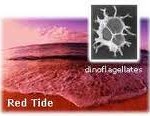Algae, like dinoflagellates, comprise a big group of marine plants and plant like organisms that serve as food for many forms of aquatic life. Hence, dinoflagellates are natural food for fishes and shellfishes.
Red tide occurs when there is a high concentration of dinoflagellates, a type of algae that produces toxic substances that are poisonous to humans.
Dinoflagellates thrive when certain environmental factors favorable to their growth come together like warm surface temperatures, high nutrient content, low salinity and calm seas.
When fishes and shellfishes (tahong or talaba) eat dinoflagellates, they store the toxins of the algae in their digestive tract.
The acceptable levels of dinoflagellates toxins set by the World Health Organization (WHO) is 80 micrograms per 100 grams of shellfish meat. Any level above this is dangerous to humans.
Dinoflagellate toxin affects the nervous system. Sign and symptoms of red tide poisoning usually occur within 30n minutes after ingestion and their severity depends on the amount of toxin taken in.
They initially consist of tingling or pricking sensations of the lips and tongue that soon radiate to the face and the extremities.
Speech impairment like hoarseness, general muscle weakness, nausea, vomiting and loose vowel movement may follow.
Severe cases of red tide poisoning are referred to as paralytic because they are characterized by paralysis and respiratory arrest within 5 to 12 hours after the appearance of the initial symptoms. If unattended paralytic red tide poisoning is highly fatal.
Treatment and coping up with red tide poisoning is best carried in a hospital setting. It includes removal of the toxin that is still in the digestive system by purgative means or by inducing to purge out the content of the stomach.
Supportive treatment like mechanical assistance of respiration is also carried out until the effect of the toxin subsides. Usually, if supportive treatment is adequate, recovery is attained spontaneously within 24 hours.
In the Philippines, the water along the coastlines is monitored by the Bureau of Fisheries and Aquatic Resources (BFAR). They report red tide and the occurrence of other harmful algal blooms to an inter-agency group of environmental health experts who will take immediate steps and action accordingly.
